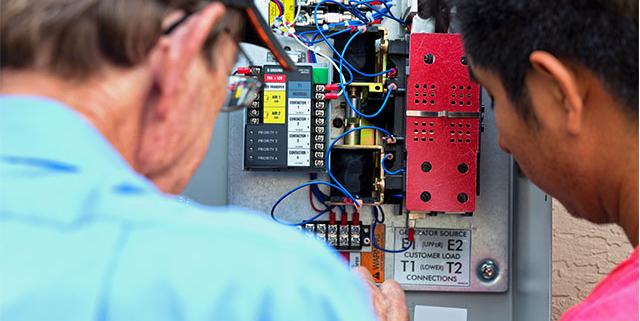How Do Transfer Switches for Generators Work? (Basics You Need to Know)
While all parts of the generator backup system are important, transfer switches are among the essential components to understand.
What Is a Transfer Switch?
The purpose of a transfer switch is to provide your home or organization with a simple and intuitive method of transferring power requirements to a backup generator when needed. Manual switches require a direct operation to start the generator, while automatic switches can do so without intervention if they detect an interruption in the main utility power. The type of transfer switch you choose depends on your needs. Organizations or homeowners who can tolerate short interruptions in power may want to select a manual switch, while those that cannot are best served by an automatic transfer switch.
Having any transfer switch in place is better than none at all. Transfer switches make the task of deriving power from a generator much easier. Without a transfer switch, an engineer or operator must manually reconnect the power supply to the generator unit which is something that is both time-consuming and dangerous. Residential homeowners and businesses may not be able to seek the services of the appropriate professionals in the event of a power outage rendering any backup generators inoperable.
How Transfer Switches Work
Automatic and manual switches work in different ways.
Automatic Switches. Both firms and homeowners must first determine the circuits that they would like to power in the event of an outage. An automatic transfer switch provides an automated way of switching the power source from the main source to generator supply. Automatic switches can sense whether there has been an interruption in power supply and switch to generator power mode in under a second. Although the speed of transfer isn’t always critical in residential settings, some commercial and public sector organizations require the transfer delay to be low enough not to interrupt operations.
Manual Switches. A manual transfer switch performs a similar operation to an automatic except it requires an operator. When the operator flips the switch, it signals to the generator to begin providing energy for the separated circuit. Manual switches, as discussed, make the job of providing backup power much more straightforward, though they may not be as suitable for some time-critical applications as automatic transfer switches.
Should You Invest In a Transfer Switch?
Your standard generator cannot operate without it! It must have a way to transfer power from the main service of the home to the generator and vise versa.
-
It’s a Requirement of Code. Transfer switches have tremendous utility, but they’re also a regulatory requirement of National Electric Codes 700.5 and 701.5 if you plan on using your generator in a commercial or residential setting.
-
It’s Safe. Transfer switches not only make switching to backup power easy but safe too. Even qualified engineers could be putting themselves in danger while manually hooking up generators to circuits, especially in low light conditions. Transfer switches take the threat out of providing power in critical situations.
-
It’s Easier. Power outages can be a major hassle if you rely on electricity for health or your work. Transfer switches allow you to get the power you need, whether automatic or manual.
Installing Transfer Switches: What to Look Out For
Although transfer switches are an essential addition to any backup power generating system, it’s not always easy to determine what you need. Here’s what you should consider:
-
The wattage rating. Like all electrical equipment, transfer switches must be suitable for the required wattage. The higher the wattage requirements of your home or organization, the heavier-duty your transfer switch will need to be. Before purchasing a transfer switch, check the wattage running through your circuits to ensure that you buy equipment with the correct tolerances.
-
Whether you need a kit. Kits provide all the materials, plans, and sometimes tools you need to install transfer switches with a minimum of fuss. Having all the parts you need can be helpful for those who don’t want to spend time researching parts.
-
Certifications. All transfer switches sold in the US must meet UL and CUL certifications. These certifications help to keep you safe.
-
Warranties. Transfer switches are only worth the money if they work as intended at a moment’s notice. If you choose a transfer switch, you want to know that the manufacturer behind it has confidence in its products. Check warranty information before making any purchase.
If you want to know more about how transfer switches work or install one in your home or organization, then get in touch with EmPower Generators today. We have all the expertise you need to make the right choice.





